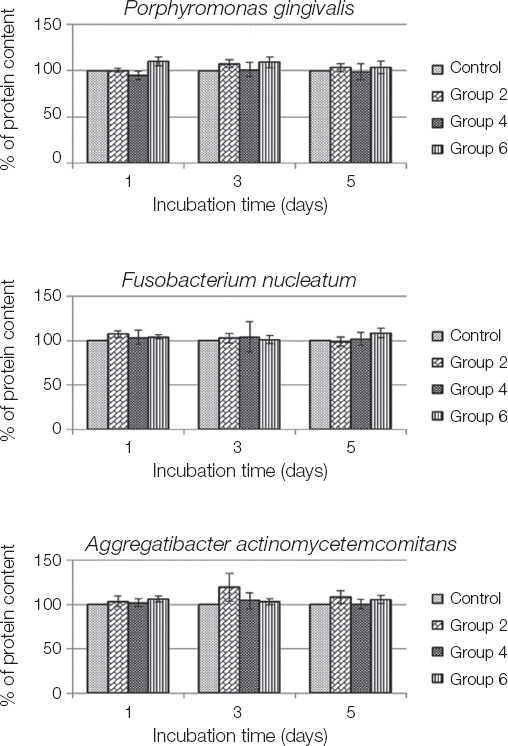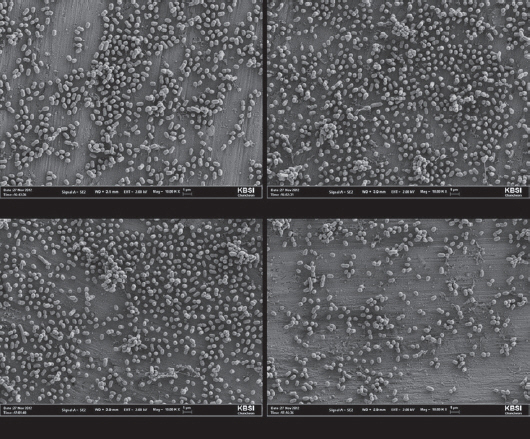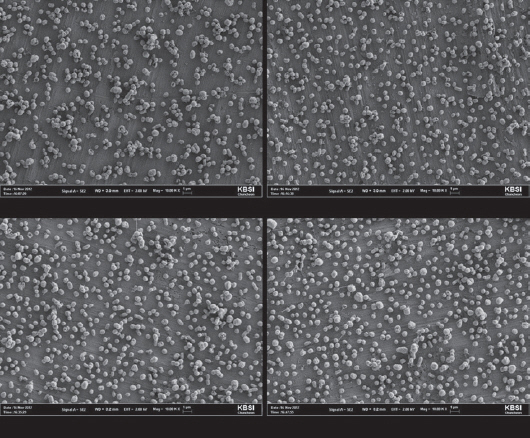J Dent Rehabil Appl Sci.
2016 Mar;32(1):16-23. 10.14368/jdras.2016.32.1.16.
Effect of fluoride-containing gel on the roughness of a titanium surface and the promotion of bacterial growth
- Affiliations
-
- 1Department of Periodontology, Research Institute for Oral Sciences, College of Dentistry, Gangneung-Wonju National University, Gangneung, Republic of Korea. hsum@gwnu.ac.kr
- 2Department of Oral Microbiology, Research Institute for Oral Sciences, College of Dentistry, Gangneung-Wonju National University, Gangneung, Republic of Korea.
- KMID: 2162375
- DOI: http://doi.org/10.14368/jdras.2016.32.1.16
Abstract
- PURPOSE
The aim of this study was to evaluate whether fluorides at various pH cause changes in the surface roughness of titanium implants that alter the adherence of bacterial biofilms.
MATERIALS AND METHODS
The titanium disks were assigned randomly to the following seven groups according to the fluoride agents and application time (1 minute or 30 minute) used: control (no treatment); group 1 (1.23% acidulated phosphate fluoride [APF] at pH 3.5 for 1 minute); group 2 (1.23% APF at pH 3.5 for 30 minute); group 3 (1.23% APF at pH 4.0 for 1 minute); group 4 (1.23% APF at pH 4.0 for 30 minute); group 5 (2% NaF gel at pH 7.0 for 1 minute); group 6 (2% NaF gel at pH 7.0 for 30 minute). The surface roughness of the titanium disks and the amount of adherent bacteria were measured.
RESULTS
Group 2 showed a significantly greater surface roughness than the control group (P < 0.0001). No significant differences in the amount of surface bacteria were observed between the treated samples and the controls. In addition, there were no significant differences in bacterial adherence relative to the incubation period between the treated samples and the controls.
CONCLUSION
The surface roughness of the titanium disks was significantly greater after treatment with APF at pH 3.5 for 30 min compared with that of the controls. In addition, we found that the amount of Porphyromonas gingivalis, Fusobacterium nucleatum, and Aggregatibactor actinomycetemcomitans was similar among all groups.
Keyword
MeSH Terms
Figure
Reference
-
References
1. Adell R, Lekholm U, Rockler B, Brånemark PI. A 15-year study of osseointegrated implants in the treatment of the edentulous jaw. Int J Oral Surg. 1981; 10:387–416. DOI: 10.1016/S0300-9785(81)80077-4.2. Buser D, Mericske-Stern R, Bernard JP, Behneke A, Behneke N, Hirt HP, Belser UC, Lang NP. Longterm evaluation of non-submerged ITI implants. Part 1:8-year life table analysis of a prospective multi-center study with 2359 implants. Clin Oral Implants Res. 1997; 8:161–72. DOI: 10.1034/j.1600-0501.1997.080302.x. PMID: 9586460.3. Romeo E, Lops D, Margutti E, Ghisolfi M, Chiapasco M, Vogel G. Long-term survival and success of oral implants in the treatment of full and partial arches: a 7-year prospective study with the ITI dental implant system. Int J Oral Maxillofac Implants. 2004; 19:247–59. PMID: 15101597.4. Zitzmann NU, Berglundh T. Definition and prevalence of peri-implant diseases. J Clin Periodontol. 2008; 35:286–91. DOI: 10.1111/j.1600-051X.2008.01274.x. PMID: 18724856.5. Heitz-Mayfield LJ. Peri-implant diseases: diagnosis and risk indicators. J Clin Periodontol. 2008; 35:292–304. DOI: 10.1111/j.1600-051X.2008.01275.x. PMID: 18724857.6. Quirynen M, Listgarten MA. Distribution of bacterial morphotypes around natural teeth and titanium implants ad modum Brånemark. Clin Oral Implants Res. 1990; 1:8–12. DOI: 10.1034/j.1600-0501.1990.010102.x. PMID: 2099212.7. Pontoriero R, Tonelli MP, Carnevale G, Mombelli A, Nyman SR, Lang NP. Experimentally induced periimplant mucositis. A clinical study in humans. Clin Oral Implants Res. 1994; 5:254–9. DOI: 10.1034/j.1600-0501.1994.050409.x. PMID: 7640340.8. Leonhardt A, Berglundh T, Ericsson I, Dahlén G. Putative periodontal pathogens on titanium implants and teeth in experimental gingivitis and periodontitis in beagle dogs. Clin Oral Implants Res. 1992; 3:112–9. DOI: 10.1034/j.1600-0501.1992.030303.x. PMID: 1290791.9. Leonhardt A, Renvert S, Dahlén G. Microbial findings at failing implants. Clin Oral Implants Res. 1999; 10:339–45. DOI: 10.1034/j.1600-0501.1999.100501.x. PMID: 10551058.10. Quirynen M, Marechal M, Busscher HJ, Weerkamp AH, Darius PL, van Steenberghe D. The influence of surface free energy and surface roughness on early plaque formation. An in vivo study in man. J Clin Periodontol. 1990; 17:138–44. DOI: 10.1111/j.1600-051X.1990.tb01077.x. PMID: 2319000.11. Bollen CM, Papaioanno W, Van Eldere J, Schepers E, Quirynen M, van Steenberghe D. The influence of abutment surface roughness on plaque accumulation and peri-implant mucositis. Clin Oral Implants Res. 1996; 7:201–11. DOI: 10.1034/j.1600-0501.1996.070302.x. PMID: 9151584.12. Teughels W, Van Assche N, Sliepen I, Quirynen M. Effect of material characteristics and/or surface topography on biofilm development. Clin Oral Implants Res. 2006; 17(Suppl2):68–81. DOI: 10.1111/j.1600-0501.2006.01353.x. PMID: 16968383.13. Quirynen M, Bollen CM. The influence of surface roughness and surface-free energy on supra- and subgingival plaque formation in man. A review of the literature. J Clin Periodontol. 1995; 22:1–14. DOI: 10.1111/j.1600-051X.1995.tb01765.x. PMID: 7706534.14. Bollen CM, Lambrechts P, Quirynen M. Comparison of surface roughness of oral hard materials to the threshold surface roughness for bacterial plaque retention: a review of the literature. Dent Mater. 1997; 13:258–69. DOI: 10.1016/S0109-5641(97)80038-3.15. Aykent F, Yondem I, Ozyesil AG, Gunal SK, Avunduk MC, Ozkan S. Effect of different finishing techniques for restorative materials on surface roughness and bacterial adhesion. J Prosthet Dent. 2010; 103:221–7. DOI: 10.1016/S0022-3913(10)60034-0.16. Dionysopoulos P, Gerasimou P, Tolidis K. The effect of home-use fluoride gels on glass-ionomer, compomer and composite resin restorations. J Oral Rehabil. 2003; 30:683–9. DOI: 10.1046/j.1365-2842.2003.01104.x. PMID: 12791152.17. Benderli Y, Gökçe K, Kazak M. Effect of APF gel on micromorphology of resin modified glassionomer cements and flowable compomers. J Oral Rehabil. 2005; 32:669–75. DOI: 10.1111/j.1365-2842.2005.01484.x. PMID: 16102080.18. Walker MP, Ries D, Kula K, Ellis M, Fricke B. Mechanical properties and surface characterization of beta titanium and stainless steel orthodontic wire following topical fluoride treatment. Angle Orthod. 2007; 77:342–8. DOI: 10.2319/0003-3219(2007)077[0342:MPASCO]2.0.CO;2.19. Khoury ES, Abboud M, Bassil-Nassif N, Bouserhal J. Effect of a two-year fluoride decay protection protocol on titanium brackets. Int Orthod. 2011; 9:432–51. DOI: 10.1016/j.ortho.2011.09.006. PMID: 22032966.20. Stájer A, Urbán E, Pelsõczi IK, Mihalik E, Rakonczay Z, Nagy K, Turzó K, Radnai M. Effect of caries preventive products on the growth of bacterial biofilm on titanium surface. Acta Microbiol Immunol Hung. 2012; 59:51–61. DOI: 10.1556/AMicr.59.2012.1.6. PMID: 22510287.21. Pröbster L, Lin W, Hüttemann H. Effect of fluoride prophylactic agents on titanium surfaces. Int J Oral Maxillofac Implants. 1992; 7:390–4.22. Hix JO, O'Leary TJ. The relationship between cemental caries, oral hygiene status and fermentable carbohydrate intake. J Periodontol. 1976; 47:398–404. DOI: 10.1902/jop.1976.47.7.398. PMID: 1065737.23. Ravald N, Hamp SE. Prediction of root surface caries in patients treated for advanced periodontal disease. J Clin Periodontol. 1981; 8:400–14. DOI: 10.1111/j.1600-051X.1981.tb00889.x. PMID: 7037864.24. Cobb HB, Rozier RG, Bawden JW. A clinical study of the caries preventive effects of an APF solution and APF thixotropic gel. Pediatr Dent. 1980; 2:263–6. PMID: 6941001.25. Horowitz HS, Doyle J. The effect on dental caries of topically applied acidulated phosphatefluoride: results after three years. J Am Dent Assoc. 1971; 82:359–65. DOI: 10.14219/jada.archive.1971.0063.26. Reclaru L, Meyer JM. Effects of fluorides on titanium and other dental alloys in dentistry. Biomaterials. 1998; 19:85–92. DOI: 10.1016/S0142-9612(97)00179-8.27. Schiff N, Grosgogeat B, Lissac M, Dalard F. Influence of fluoride content and pH on the corrosion resistance of titanium and its alloys. Biomaterials. 2002; 23:1995–2002. DOI: 10.1016/S0142-9612(01)00328-3.28. Toniollo MB, Tiossi R, Macedo AP, Rodrigues RC, Ribeiro RF, Mattos Mda G. Effect of fluoridecontaining solutions on the surface of cast commercially pure titanium. Braz Dent J. 2009; 20:201–4. DOI: 10.1590/S0103-64402009000300005. PMID: 19784464.29. Amoroso PF, Adams RJ, Waters MG, Williams DW. Titanium surface modification and its effect on the adherence of Porphyromonas gingivalis: an in vitro study. Clin Oral Implants Res. 2006; 17:633–7. DOI: 10.1111/j.1600-0501.2006.01274.x. PMID: 17092220.30. Kim YJ, Jang KT, Garcia-Godoy F. Effect of acidulated phosphate fluoride (APF) gel on the adherence of cariogenic bacteria to resin composites. Am J Dent. 2005; 18:91–4. PMID: 15973825.
- Full Text Links
- Actions
-
Cited
- CITED
-
- Close
- Share
- Similar articles
-
- Effect of Fluoride Recharging on Fluoride Release and Surface Properties of Orthodontic Bracket Adhesives
- Effect of surface roughness on bond strength in titanium-porcelain system
- Effect of titanium surface roughness on adhesion and differentiation of osteoblasts
- Comparison in Demineralization Resistance of Resin Infiltration and 1.23% Acidulated Phosphate Fluoride in Bovine Teeth
- Fabrication of rough surface on titanium using electrochemical treatment in NaCl electrolyte





